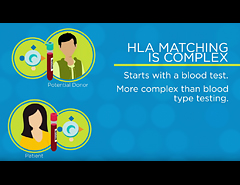 Watch this short animated video to learn more about what HLA matching is and why a close HLA match is important.
Watch this short animated video to learn more about what HLA matching is and why a close HLA match is important.
The best marrow transplant outcomes happen when a patient’s human leukocyte antigen (HLA) and the HLA of a registry member or cord blood unit closely match. This is much more complex than matching blood types. HLA is a protein – or marker – found on most cells in your body. Your immune system uses HLA markers to know which cells belong in your body and which do not. There are many HLA markers that make a person’s tissue type unique; however, matching certain markers is what is critical to a successful transplant.

What makes a close match?
The NMDP Registry is a listing of potential donors and cord blood units and their HLA types. When people join the NMDP Registry, they provide a sample of their DNA by swabbing their cheek. This cheek swab is tested for a minimum of 6 basic HLA markers.
A patient’s doctor will usually choose several donors who appear to match the patient at a basic level. The doctor will ask that these donors have additional tests. These detailed tests will show which donor’s HLA most closely matches the patient’s HLA markers. These tests are usually blood tests or additional cheek swabs.
About 8% of members who complete additional testing will go on to donate. If a member is asked to donate, that means they are the closest HLA match to the patient – the best donor.
